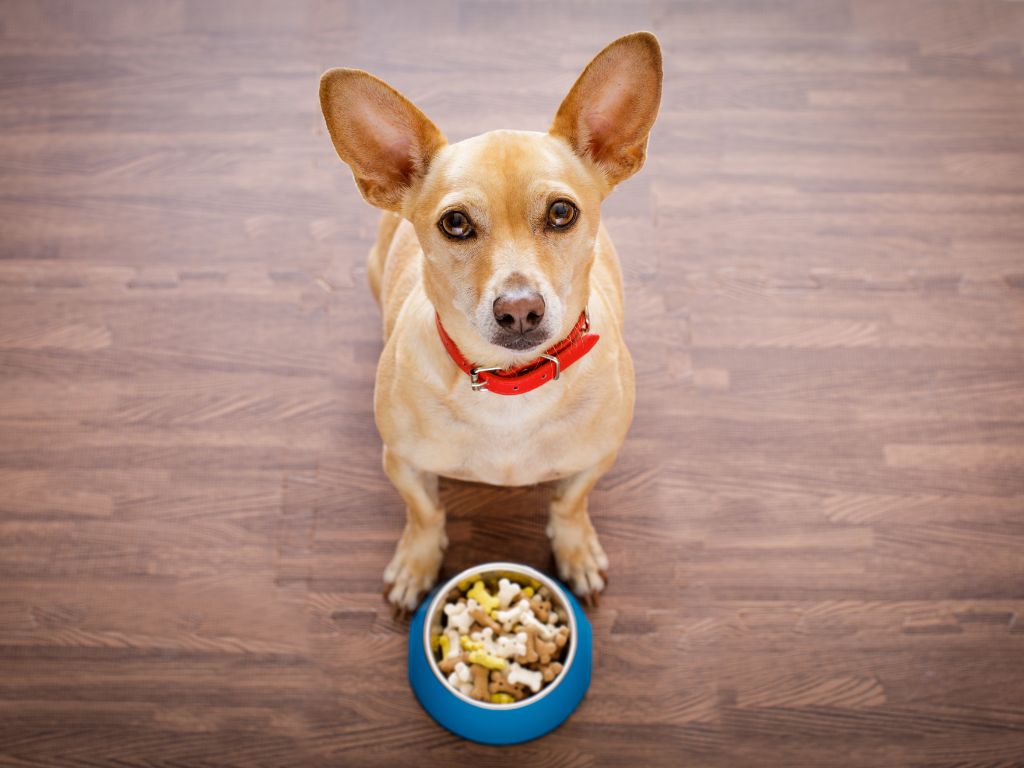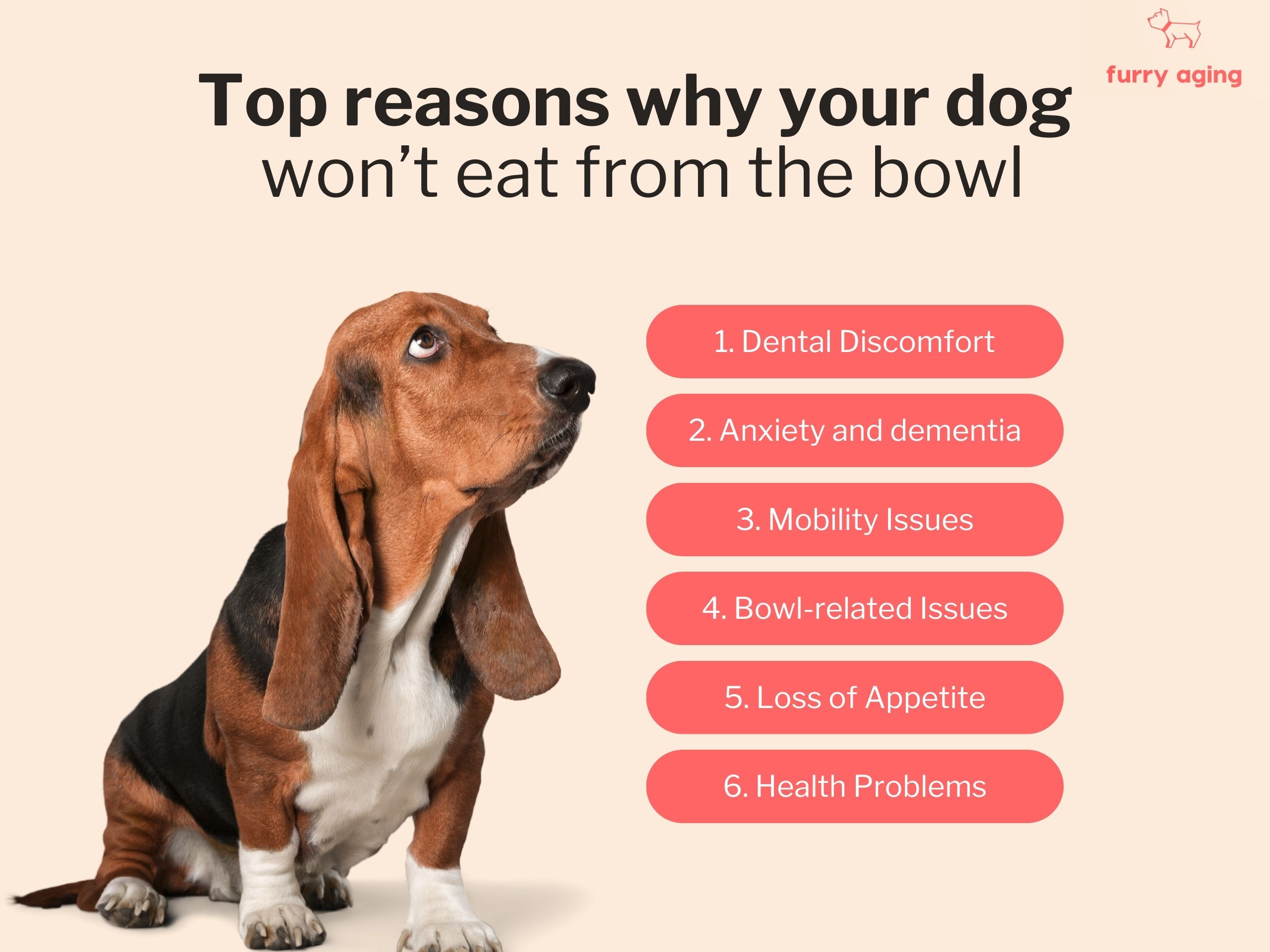
Has your old dog suddenly changed its eating behavior, refusing to touch their food bowl but devouring treats from your hand? Don’t worry – you’re not alone.
Many old dogs stop eating from the bowl because of dental pain, mobility issues, behavioral problems, problems with the bowl and feeding environment, or more serious medical conditions.
In this article, we review the potential causes and strategies to ensure your dog gets the right amount of nutrients.
Tales from the tails 🐕
I learned firsthand the challenges. Our family dog, Mumi, began experiencing difficulties with his meals at the age of 12. His battles with doggie dementia and spondylosis, a spine-related disease, created unique challenges. We saw him struggling to lean down and reach his food in the bowl. So we elevated his bowls to a more accessible height, but he would tip the bowl and scatter his food.
As his condition progressed, his coordination was compromised, and his bowl was now an obstacle. The solution we found was to hand-feed Mumi. He enjoyed sitting on the couch next to my mom, and the vet encouraged us to continue doing it as long as he ate.
But hand-feeding is not the only solution, and the approach depends on what is causing your dog to avoid the bowl in the first place.
Understanding Hand-feeding Behavior
There are many valid reasons (at least from your dog’s perspective) to prefer eating from your hand over their bowl, some include:
- They feel more secure with you.
- They are looking for opportunities to strengthen the bond with you.
- They may feel sick and need extra care those days but will return to eating from their plate after recovering.
- They could be bored and are looking to interact with you.
- Other animals are disturbing your dog’s meal time.
- You may have accidentally reinforced this behavior by hand-feeding them as puppies, or when they were acting picky.
Is Hand Feeding Bad for Your Dog?
This behavior is not bad per se. Hand feeding is often used for dog training because it creates a positive association between your hand and tasty treats. But, it may not be realistic to hand-feed them for every meal.
Why Won’t My Dog Eat from the Bowl?

1. Dental Discomfort
Senior dogs can develop dental problems such as gum disease or tooth decay, and chewing hard kibble from a bowl might be painful. Also, the sensation of bumping their nose against the bowl’s sides can worsen the discomfort.
2. Anxiety and Canine Cognitive Dysfunction
Older dogs can become more anxious or experience cognitive decline, causing changes in behavior. They might prefer to eat from your hand to seek comfort and security.
3. Mobility Issues
Arthritis and other age-related mobility issues can make it uncomfortable for older dogs to bend down and eat from a bowl.
4. Bowl-Related Issues
Sometimes, the problem is the bowl itself:
- Wrong height: If the bowl is too high or too low it can be uncomfortable for dogs with mobility issues or arthritis.
- Wrong shape: Bowls that are too deep or narrow are not ideal because they represent a struggle to reach the food at the bottom. Besides, some dogs just don’t like their ears, whiskers, or collars touching the bowl.
- Wrong material (often metal bowls): Some dogs may get scared or intimidated by their reflection in a metal bowl, especially those with deteriorating eyesight.
5. Loss of Appetite
Senior dogs could experience a decreased sense of smell and taste, causing them to reduce their excitement at mealtime. In addition, they may not be getting enough physical activity, contributing to reduced appetite.
6. Health Problems
Sadly, other serious medical conditions could be the reason why your dog hasn’t been eating, such as:
- Heart disease
- Lung disease
- Pancreatitis
- Kidney disease
- Liver disease
- Diabetes
- Cancer
These conditions cause them to sleep more, eat less, and change behavioral patterns, and they may be more common among senior dogs.
How to Make Your Dog Eat From His Bowl?
Change their Diet
- Switch to soft food formulated for their age. These foods are gentler on their teeth and offer the nutrients for their age.
- Try different textures and aromas. Mix in small amounts of wet food and add aromatic toppers.
- Keep rotating flavors to avoid boredom (beef, chicken, turkey, salmon, etc.).
- Add tasty toppings like chicken or bone broth, pumpkin pure, sweat potato pure, or sprinkle dry liver treats.
Dental Care
Make adjustments to your dog’s dental care. Introduce daily dental chews, brush their teeth regularly, and include foods rich in zinc, calcium, phosphorus, B-complex vitamins, and antioxidants.
🔍 For more detailed information on senior dog dental care, you can check out our Comprehensive Guide to Senior Dog Dental Care.
Make The Feeding Station More Accessible
Consider raising the bowls to the height of your dog’s chest to bring the food closer to your dog’s mouth and alleviate the discomfort. This can be especially helpful for dogs with mobility issues or arthritis who struggle to bend down. You can use elevated feeding stations or simply place the bowls on a shoe box.
You can add extra support by placing a non-slip mat underneath the feeding station to prevent it from sliding while your dog eats. This will provide stability and prevent messes.
Address Cognitive Decline
If you suspect your dog is experiencing cognitive decline, it’s important to consult with your vet. They can guide the appropriate treatment for doggie dementia, which may include making adjustments to your dog’s routine, environment, diet, and supplementation. These interventions can help slow down the progression of the condition and improve your pup’s overall wellness.
Change the Bowl
Try other materials such as ceramic and plastic bowls, or explore alternatives beyond bowls, such as feeding mats, paper plates, or slow feeders. Here are some options:
- Ceramic Dog Bowls with Bone Patterns
- Dogs Slow Feeder Licking Mat
- Interactive Feed Puzzle for Boredom
- DogBuddy Dog Food Mat
Clean their Bowls Regularly
Pet bowls can quickly collect bacteria when the food is left out for too long. To prevent this, clean it after every meal using hot water and soap, and save it for the next use.
Changes in the Environment
- Move the bowl somewhere they can eat at their own pace.
- If you have more than one dog, feed them in separate rooms.
- Stay with them while they eat to provide company and reassurance.
- Adjust their feeding time to a more relaxed hour instead of when everyone is rushing around.
🐶 Mumi’s Pick:
- Wet Food: Blue Buffalo Homestyle Recipe (Chicken with Vegetables)
- Wet Food: Hill’s Science Diet Adult 7+ Savory Stew
- Treats: Zuke’s Mini Naturals Treats
- Dental Chews: Greenies Aging Care
When Should I Take My Dog To The Vet?
Pay attention to these signs that may require a visit to the vet:
- Your dog’s eating habits change significantly, and he refuses to eat for an extended period.
- Your dog has other symptoms such as lethargy, vomiting, diarrhea, pacing, or appears to be in pain.
- Your dog is consistently losing weight.
Conclusion
As dogs age, their eating habits may change. If your senior dog avoids their bowl but accepts food from your hand, try to determine why and approach the issue with care and patience. In the end, if your senior dog prefers to be hand-fed, it can be a positive experience, as long as you avoid reinforcing any anxious behaviors.
FAQs
Many dogs drop food from their bowl on the floor due to instinctual behavior. Reasons include storing food for later, disliking the bowl or food, or medical conditions like arthritis.
Hand-feeding your dog can be a good thing when you find the right balance. The benefits include a great opportunity to train them, build a strong bond, boost their confidence, and slow down quick eaters.
If your dog is drinking water but not eating, it is advisable to take them to the vet to rule out any health conditions. Common reasons for this behavior include stress, nausea, dental disease, gastrointestinal issues, changes in the environment, or other chronic illnesses such as kidney disease or cancer.
Your dog may have learned to eat from your hand due to past experiences like being picky or sick, changing dog food, or coming from a hand-feeding environment such as a shelter or previous owner.
Related Articles:
- Optimal Senior Dog Food: Nutrition for Healthy Aging
- How to Help Your Senior Dog Gain Weight
- Why Is My Senior Dog Losing Weight But Still Eating?
Recent Posts
What Your Dog's Poop Reveals (Healthy Poops and Warning Signs)
An unusual poop could be concerning but does not necessarily mean our dog is in danger or sick. Especially, if they are otherwise behaving normally and not showing any signs of pain. I still...
I recently learned that AI can predict kidney diseases in pets that will occur two years from now with high accuracy, and this got me thinking if it could have changed my dog's fate. Could we have...
